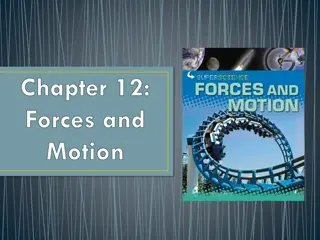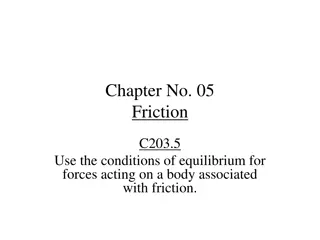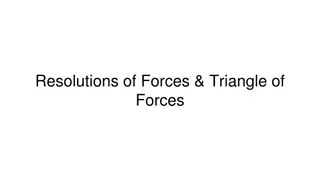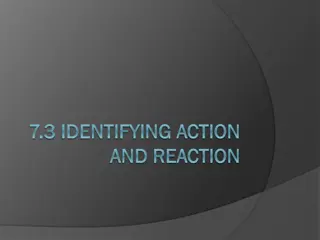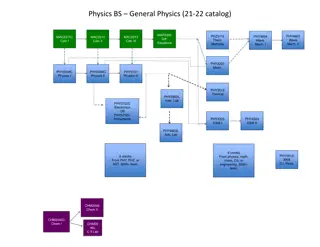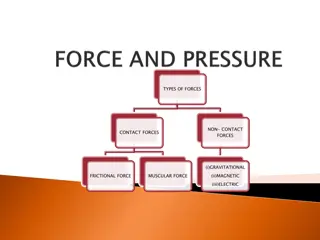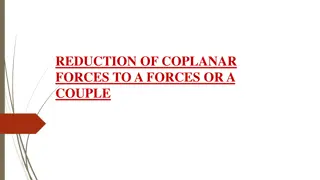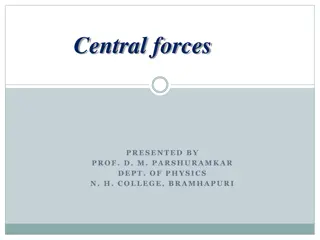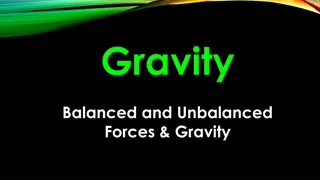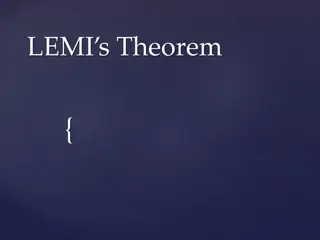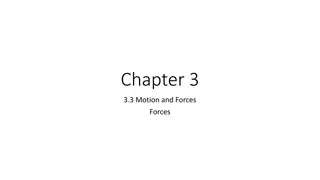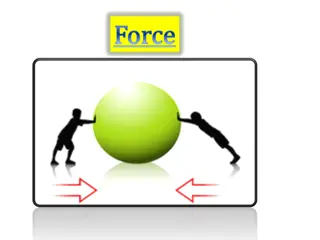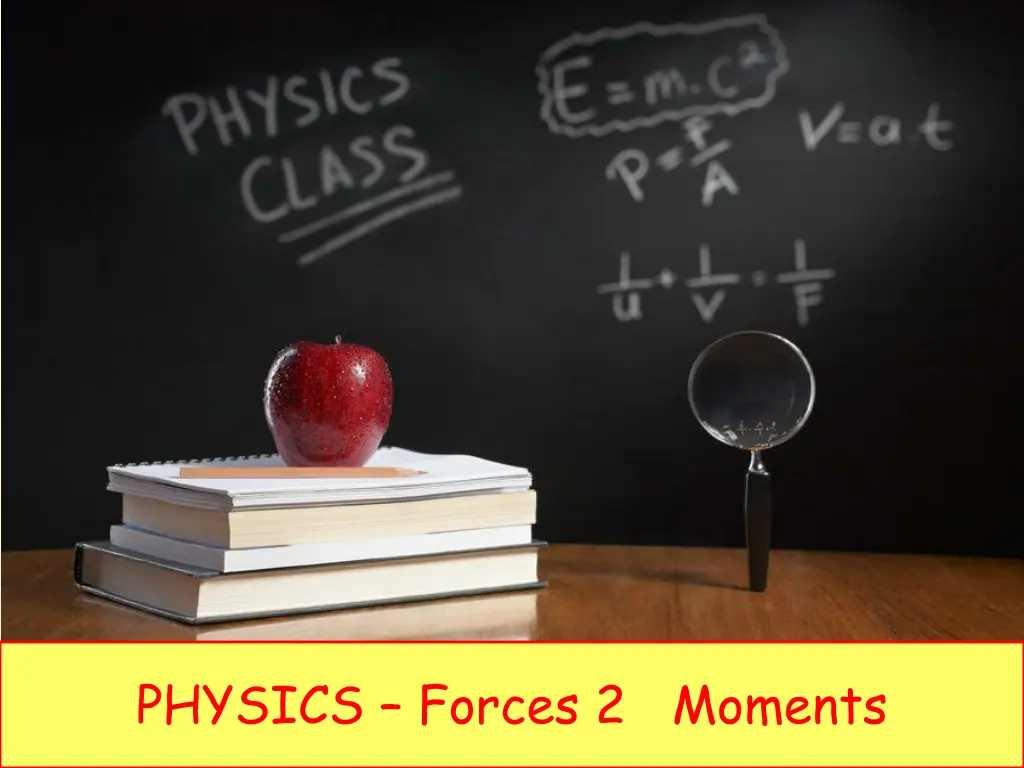
Understanding Forces and Moments in Physics
Explore the concepts of forces and moments in physics, focusing on the turning effect of forces, equilibrium conditions, moments calculation, and practical applications like using spanners for tightening nuts. Discover how increasing force or distance affects moments and learn to apply the principle of moments to various situations.
Download Presentation

Please find below an Image/Link to download the presentation.
The content on the website is provided AS IS for your information and personal use only. It may not be sold, licensed, or shared on other websites without obtaining consent from the author. If you encounter any issues during the download, it is possible that the publisher has removed the file from their server.
You are allowed to download the files provided on this website for personal or commercial use, subject to the condition that they are used lawfully. All files are the property of their respective owners.
The content on the website is provided AS IS for your information and personal use only. It may not be sold, licensed, or shared on other websites without obtaining consent from the author.
E N D
Presentation Transcript
LEARNING OBJECTIVES 1.5.2 Turning effect Core Describe the moment of a force as a measure of its turning effect and give everyday examples Understand that increasing force or distance from the pivot increases the moment of a force Calculate moment using the product force perpendicular distance from the pivot Apply the principle of moments to the balancing of a beam about a pivot Supplement Apply the principle of moments to different situations 1.5.3 Conditions for equilibrium Core Recognise that, when there is no resultant force and no resultant turning effect, a system is in equilibrium Perform and describe an experiment (involving vertical forces) to show that there is no net moment on a body in equilibrium
LEARNING OBJECTIVES 1.5.2 Turning effect Core Describe the moment of a force as a measure of its turning effect and give everyday examples Understand that increasing force or distance from the pivot increases the moment of a force Calculate moment using the product force perpendicular distance from the pivot Apply the principle of moments to the balancing of a beam about a pivot Supplement Apply the principle of moments to different situations 1.5.3 Conditions for equilibrium Core Recognise that, when there is no resultant force and no resultant turning effect, a system is in equilibrium Perform and describe an experiment (involving vertical forces) to show that there is no net moment on a body in equilibrium
Forces and moments Spanners are used for tightening and loosening nuts. They help to produce a larger turning effect.
Forces and moments The longer the spanner, the greater the turning effect (force) Spanners are used for tightening and loosening nuts. They help to produce a larger turning effect.
Forces and moments The longer the spanner, the greater the turning effect (force) Spanners are used for tightening and loosening nuts. They help to produce a larger turning effect.
Forces and moments Moment of = force x perpendicular a force about distance from a point the point
Forces and moments Moment of = force x perpendicular a force about distance from a point the point Moments may be described as clockwise or anticlockwise, and the moment of a force is also called a torque.
Forces and moments Moment of = force x perpendicular a force about distance from a point the point Don t forget that the unit of Force ie the Newton (N) Moments may be described as clockwise or anticlockwise, and the moment of a force is also called a torque.
Forces and moments To increase the force applied to undoing a wheel nut, extend the length of the spanner you can do this by inserting a length of pipe over the end.
Lets look at a few examples of calculations involving moments. 4m X 5N Moment about X = 5 x 4 = 20N (clockwise)
3N Let s look at a few examples of calculations involving moments. X 5m Moment about X = 3 x 5 = 15N (anticlockwise) 4m X 5N Moment about X = 5 x 4 = 20N (clockwise)
3N Let s look at a few examples of calculations involving moments. X 5m Moment about X = 3 x 5 = 15N (anticlockwise) 4m X Principle of moments 5N Moment about X = 5 x 4 = 20N (clockwise)
LEARNING OBJECTIVES 1.5.2 Turning effect Core Describe the moment of a force as a measure of its turning effect and give everyday examples Understand that increasing force or distance from the pivot increases the moment of a force Calculate moment using the product force perpendicular distance from the pivot Apply the principle of moments to the balancing of a beam about a pivot Supplement Apply the principle of moments to different situations 1.5.3 Conditions for equilibrium Core Recognise that, when there is no resultant force and no resultant turning effect, a system is in equilibrium Perform and describe an experiment (involving vertical forces) to show that there is no net moment on a body in equilibrium
The Principle of Moments This beam is in a state of balance.
The Principle of Moments This beam is in a state of balance. In order to be balanced, the clockwise forces must be equal to the anticlockwise forces. We say that the beam is in a state of equilibrium.
The Principle of Moments This beam is in a state of balance. In order to be balanced, the clockwise forces must be equal to the anticlockwise forces. We say that the beam is in a state of equilibrium. The Principle of Moments states that: If an object is in equilibrium, the sum of the clockwise moments about any point is equal to the sum of the anticlockwise moments about that point.
The Principle of Moments Let s look at some worked examples 1m 2m X 20N 10N Anticlockwise moment = 20 x 1 = 20Nm Clockwise moment = 10 x 2 = 20Nm
The Principle of Moments Let s look at some worked examples 1m 2m 0.5m X 20N 20N 5N Anticlockwise moment = 20 x 1 = 20Nm Combined clockwise moment = (5 x 2) + (20 x 0.5) = 20Nm
What force does the trailer exert on the hitching point, and what force do the rear tyres exert on the road? The Principle of Moments Rear tyres (consider as a single force) Hitching point
What force does the trailer exert on the hitching point, and what force do the rear tyres exert on the road? The Principle of Moments Centre of mass of trailer 6m 3m 400 kN
What force does the trailer exert on the hitching point, and what force do the rear tyres exert on the road? The Principle of Moments Centre of mass of trailer X 6m 3m 400 kN A At the hitching point, the downward force of the trailer on the hitch is equal to the upward force of the hitch on the trailer (X).
What force does the trailer exert on the hitching point, and what force do the rear tyres exert on the road? The Principle of Moments Centre of mass of trailer Y X 6m 3m 400 kN A B The downward force of the rear tyres on the road is equal to the upward force of the road on the tyres (Y). At the hitching point, the downward force of the trailer on the hitch is equal to the upward force of the hitch on the trailer (X).
What force does the trailer exert on the hitching point, and what force do the rear tyres exert on the road? The Principle of Moments Centre of mass of trailer Y X 6m 3m 400 kN A B To find X, look at the moments about point B Clockwise moment = X x 9m Anticlockwise moment = 400kN x 6m = 2400kN m X x 9m = 2400 kN m So: X = 266.7 kN So: downward force on hitching point = 266.7kN
What force does the trailer exert on the hitching point, and what force do the rear tyres exert on the road? The Principle of Moments Centre of mass of trailer Y X 6m 3m 400 kN A B To find Y: Total upward force = Total downward force So: X + Y = 400kN So: 266.7 + Y = 400kN So: Y = 400kN - 266.7kN Y = 133.3kN So: the downward force from rear tyres = 133.3kN
LEARNING OBJECTIVES 1.5.2 Turning effect Core Describe the moment of a force as a measure of its turning effect and give everyday examples Understand that increasing force or distance from the pivot increases the moment of a force Calculate moment using the product force perpendicular distance from the pivot Apply the principle of moments to the balancing of a beam about a pivot Supplement Apply the principle of moments to different situations 1.5.3 Conditions for equilibrium Core Recognise that, when there is no resultant force and no resultant turning effect, a system is in equilibrium Perform and describe an experiment (involving vertical forces) to show that there is no net moment on a body in equilibrium

